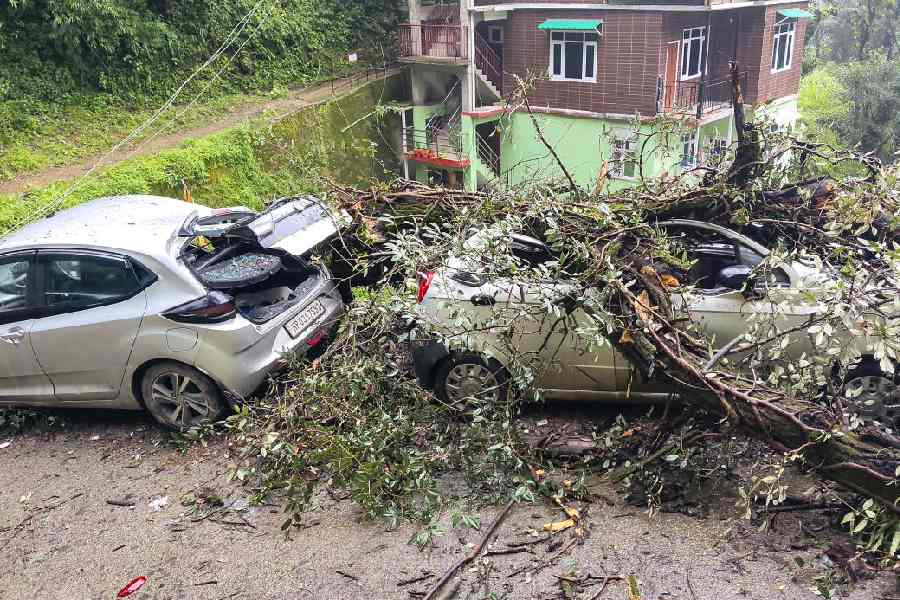 |
| A man surveys the debris left behind by the killer waves on a tsunami-hit island |
The devastation caused by the recent quake off Sumatra has put a question mark on the possibility of accurate seismic prediction
The catastrophy of the Sumatra earthquake on December 26 and the resulting devastation poses a billion-dollar question: Can we predict earthquakes accurately? The rumour of earthquakes in India, especially in the Northeast, is increasing everyday and is only strengthened by the small tremors every now and then.
One of the positive results of the recent earthquake is a growing concern among the people and authorities to prepare themselves for possible earthquakes. Now, even common people know which areas are highly seismic. But the question that haunts them is exactly when and where the next earthquake will occur.
Unfortunately, at present, it is almost impossible to predict an earthquake with precision. Although a great deal is known about where earthquakes are likely to occur, there is no reliable way to predict the day or month or the specific location where the tremors will strike. Without entering into the detailed technological interdisciplinary knowledge, let us see why.
Earthquake prediction is usually defined as the specification of the time, location and magnitude of a future earthquake within stated limits. A prediction would have to be reliable and accurate to justify the cost of response. The goal of earthquake prediction is to give warning of potentially damaging earthquakes early enough to allow appropriate response to the disaster, enabling people to minimise loss of life and property.
The significance of prediction studies may be classified into two categories: scientific and socio-economic. Earthquake prediction still remains a huge challenge to science and its accuracy could help mitigate the hazard that the calamity entails. Innumerable lives and valuable property can be saved, and the effects on social and industrial activities can be minimised. Scientific understanding of earthquakes is of vital importance to any nation.
Scientists estimate earthquake probabilities in two ways ? by studying the history of large earthquakes in a specific area and the rate at which strain accumulates in the rock. This research includes field, laboratory and theoretical investigations of earthquake mechanisms and fault zones. Ultimately, scientists would like to be able to specify a high probability for a specific earthquake on a fault within a particular time.
An earthquake results from sudden slip on a geological fault. Such fracture and failure problems are notoriously intractable. The heterogeneous state of the earth and the inaccessibility of the fault zone to direct measurement impose further difficulties. Except during a brief period in the seventies, the leading seismological authorities of each era have generally concluded that earthquake prediction is not feasible. Worldwide, each year there are about 18 earthquakes of a magnitude of 7 or more on the Richter scale. Actual annual numbers since 1968 have ranged from lows of six to seven events a year in 1986 and 1990 to highs of 20-23 events a year in 1970, 1971 and 1992.
Although scientists are not able to predict individual earthquakes, few large earthquakes do have a clear spatial pattern, and ?forecasts? of the locations and magnitudes of some future large earthquakes can be made.
If a fault segment is known to have broken during a large earthquake in the past, the recurrence time and probable magnitude can be estimated based on the fault segment size, rupture history and strain accumulation. This forecasting technique can only be used for well-understood faults, such as the San Andreas. No such forecasts can be made for poorly understood faults, such as those, which caused the 1994 Northridge, California, and the 1995 Kobe, Japan, quakes. Earthquake prediction is a popular pastime for psychics and pseudo-scientists, and extravagant claims of past success are common. Predictions claimed as ?successes? may rely on a restatement of well-understood long-term geologic earthquake hazards or are so broad and vague that they are fulfilled by typical background seismic activity. Neither tidal forces nor unusual animal behaviour have been useful in predicting earthquakes. The National Earthquake Prediction Evaluation Council reviews such predictions, but no generally useful method of predicting earthquakes has yet been found.
One well-known successful earthquake prediction was the Haicheng, China, earthquake of 1975, when an evacuation warning was issued the day before an earthquake of 7.3 magnitude occurred, thanks to some events in the preceding months. Unfortunately, most earthquakes do not have such precursors. In spite of their success in 1975, there was no warning of the 1976 Tangshan earthquake, magnitude 7.6, which caused an estimated 250,000 casualties. Scientists study the past frequency of large earthquakes in order to determine the future likelihood of similar large shocks. For example, if a region has experienced four earthquakes of the magnitude 7 or more during 200 years of recorded history, and if these shocks occurred at a random pace, then scientists would assign a 50 per cent probability (that is, just as likely to happen as not to happen) to the occurrence of another magnitude 7 or larger quake in the region during the next 50 years.
But in many places, the assumption of random occurrence with time may not be true because when strain is released along one part of the fault system, it may actually increase on another part.
Another way to estimate the likelihood of future earthquakes is to study how fast strain accumulates. When plate movements build the strain in rocks to a critical level, like stretching a rubber band too much, the rocks will suddenly break and slip to a new position. Scientists measure how much strain accumulates along a fault segment each year, how much time has passed since the last earthquake along the segment, and how much strain was released in the last earthquake. This information is then used to calculate the time required for the accumulating strain to build to the level that results in an earthquake. However, this simple model is complicated by the fact that such detailed information about faults is rare.
Another trend is the increasing use of probabilities in communicating earthquake information to the public. Instead of predicting the time, place and magnitude of a future earthquake, recent public-policy documents attempt to estimate an earthquake probability in a given window of time, space and magnitude. Probability is a relatively new concept in human history. The origin of the theory of probability goes back to the 17th century, when B. Pascal and P. de Fermat exchanged letters on dice. The concept appears to be useful in dealing with difficult problems in human society.
In addition to the above new trends, namely hypothesis testing and the use of probabilities, a more fundamentally important new trend is recognised to simulate the complex space-time-magnitude behaviour of earthquake occurrence by physical modelling.










